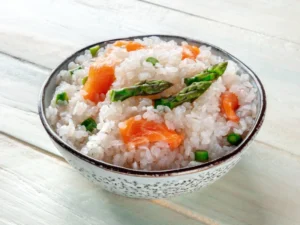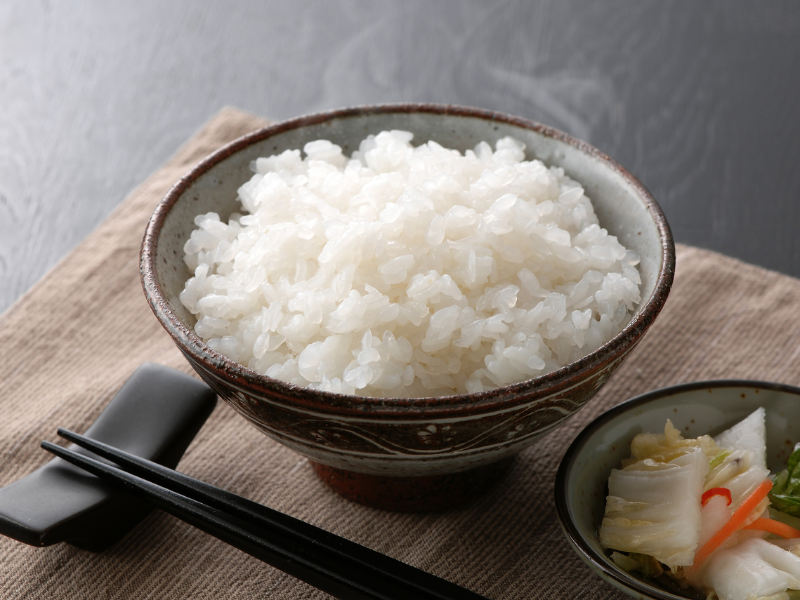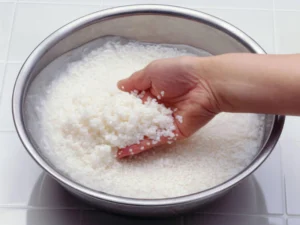In a world where dietary choices often feel like a balancing act, finding guilt-free alternatives can seem like a daunting task. Shirataki rice, affectionately known as “miracle rice,” has emerged as a beloved substitute, offering a low-calorie option without sacrificing fullness. If you’re interested in exploring this innovative rice alternative, then let’s embark on this delicious journey together.
Discovering Shirataki Rice: What Is It?
 At first glance, you might mistake shirataki rice for the regular rice pantry staple that graces many tables. However, shirataki rice is quite different. This rice is made from the root of the konjac plant, and it’s composed almost entirely of water and soluble fiber, resulting in its low caloric value.
At first glance, you might mistake shirataki rice for the regular rice pantry staple that graces many tables. However, shirataki rice is quite different. This rice is made from the root of the konjac plant, and it’s composed almost entirely of water and soluble fiber, resulting in its low caloric value.
The texture of shirataki rice might take some getting used to. Its gelatinous, slightly chewy consistency can contrast with the fluffy and starchy nature of traditional rice. This rice alternative lacks the carbs that most people associate with a filling meal, making it an attractive option for those monitoring their dietary intake.
Introducing Shirataki: A Low-Calorie Wonder
So, how low can the caloric count actually go? Shirataki rice boasts an astonishing 10 to 20 calories per serving, depending on the brand. This means that you can indulge in a generous serving without worrying about your overall caloric intake. For those on a weight-loss journey, shirataki rice allows you to eat more volume while consuming fewer calories.
When you consider how easy it is to enjoy a satisfying serving without the guilt, shirataki rice stands out. Plus, it can be integrated into countless dishes, from stir-fries to curries, making it adaptable to various cuisines and flavors.
Glucomannan: The Secret Ingredient

Photo from: https://www.verywellhealth.com/glucomannan-benefits-side-effects-dosage-7570330
The reason shirataki rice is so low in calories lies in its primary ingredient: glucomannan. This remarkable soluble fiber essentially swells in your stomach upon absorption of water, creating a gel-like substance. The result is a sensation of fullness that can help curb appetite and prevent overeating.
For many people, overeating is one of the main culprits of weight gain. By introducing glucomannan into your diet, shirataki rice can play a significant role in regulating hunger. Not only does it help manage cravings, but it also has potential benefits for individuals looking to stabilize blood sugar levels.
The Origins of Shirataki Rice
Shirataki rice has deep roots in Asian cuisine, particularly in Japan. The konjac plant has been cultivated for centuries, often primarily used for making konjac noodles. As culinary creativity flourished, chefs began to explore new uses for konjac, leading to the advent of shirataki rice.
Today, the rise in popularity of low-carb diets has made shirataki rice more common in health-conscious kitchens all around the world. Its chewy texture and ability to absorb flavors make it an exciting addition to many dishes, and it continues to gain loyal fans eager to explore new diet-friendly recipes.
Health Benefits of Shirataki Rice
Beyond just being an intriguing rice alternative, shirataki rice offers a variety of health benefits. Whether you’re dipping your toes into the health world or are already on a wellness journey, understanding these advantages can help you see the potential of shirataki rice.
Weight Loss Friendly
 For individuals focused on weight loss, shirataki rice is an excellent friend. Its minimal calories mean you can enjoy larger portions without the weight gain that often accompanies larger servings of traditional rice. This helps alleviate feelings of deprivation that often accompany dieting.
For individuals focused on weight loss, shirataki rice is an excellent friend. Its minimal calories mean you can enjoy larger portions without the weight gain that often accompanies larger servings of traditional rice. This helps alleviate feelings of deprivation that often accompany dieting.
Research suggests that increasing fiber intake can lead to weight loss due to the increased fullness that fiber provides. Shirataki rice is quite high in fiber due to its glucomannan content, making it very weight-loss friendly. The good news is that you can enjoy dishes you love without the added carbs and calories that come with traditional rice.
Diabetic Friendly
For people managing diabetes, selecting the right foods can pose challenges. Shirataki rice is a fantastic option due to its negligible sugar content. It won’t send your blood sugar levels soaring, making it an ideal addition to meals for those looking to maintain stable glucose levels.
Glucomannan’s properties can even contribute to improved insulin sensitivity. Pair this with a balanced diet, and shirataki rice can become a part of a healthy lifestyle for individuals managing diabetes.
Nutritional Profile Compared to Regular Rice
To better understand the benefits of shirataki rice, let’s take a closer look at its nutritional profile compared to regular rice. The disparity is striking and worth noting.
| Nutrient | Shirataki Rice (1 cup) | White Rice (1 cup) | Brown Rice (1 cup) |
| Calories | 10-20 | 205 | 215 |
| Carbohydrates | 1g | 45g | 45g |
| Dietary Fiber | 3g | 1g | 4g |
| Protein | 1g | 4g | 5g |
| Fat | 0g | 0g | 2g |
This table summarizes the noticeable contrasts between shirataki rice and traditional rice options. The low-calorie count, minimal carbohydrates, and higher fiber content underscore shirataki rice’s appeal as a healthier choice.
How to Prepare Shirataki Rice
Are you excited to try shirataki rice? Cooking it may be simpler than you think. With just a few steps, you can transform this unique rice alternative into a dish that delights your taste buds.
 Step-by-Step Cooking Guide
Step-by-Step Cooking Guide
- Drain and Rinse: Start by draining the shirataki rice from its packaging. Rinse it thoroughly under cold water for several minutes. This step helps remove any unwanted odor.
- Boil: Next, bring a pot of water to a boil and gently add the shirataki rice. Boil for 2 to 3 minutes to help firm up the texture and reduce any lingering odors.
- Sauté: After boiling, drain the rice yet again. You can sauté it in a non-stick pan for about 5-10 minutes. This will help evaporate any leftover moisture and enhance the overall texture.
- Serve: Finally, it’s ready to integrate into your favorite dishes! Use it in stir-fries, savory soups, or as a base for warming curries.
Tips for Flavoring Shirataki Rice
While shirataki rice has a mild flavor on its own, enhancing it with the right ingredients can create a truly delicious dish. Here are some thoughtful suggestions to infuse flavor into your meal:
- Soy Sauce or Tamari: A splash of either can work wonders in giving the rice a rich umami taste.
- Garlic and Onions: Sautéed garlic and onions elevate the aroma and taste of shirataki rice.
- Broth: Cooking the rice in flavorful broth instead of water can dramatically change the flavor profile of the dish.
- Herbs and Spices: Don’t hesitate to experiment. Incorporate any spices or herbs you enjoy, such as curry powder, cilantro, or even a blend of Italian herbs, for a fragrant finish.
Common Mistakes to Avoid
Mistakes can happen, especially when trying something new. Here are a few common pitfalls to avoid:
- Skipping the Rinse: Rinsing the rice is a vital step in the process. This drastically improves the taste and texture of your dish.
- Overcooking: Be cautious not to overcook the rice during boiling or sautéing, as this can lead to a mushy mishap.
- Not Flavoring: Recognize that shirataki rice can taste bland on its own. Always integrate it with flavorful sauces or seasoning to enhance the overall experience.
Ways to Incorporate Shirataki Rice into Your Diet

Photo from: https://www.youtube.com/watch?v=mneo2GQC04k
Now that you are equipped with the basics of cooking, it’s time to explore how to integrate shirataki rice into your meals meaningfully. It can be an exciting addition to your dietary routines.
Delicious Shirataki Rice Recipes
Are you looking for inspiration? Here are a few tasty recipes that incorporate shirataki rice:
- Stir-Fried Shirataki Rice: Sauté it with colorful vegetables like bell peppers, broccoli, and carrots. Add a dash of soy sauce, and you have a quick, gratifying meal.
- Shirataki Rice Risotto: Create a creamy risotto using shirataki rice by slowly incorporating homemade broth and stirring in some grated cheese until it melts into a delightful dish.
- Shirataki Sushi: Use shirataki rice to make low-carb sushi rolls. Fill with your preferred fish or vegetables, and wrap them in nori for a refreshing twist.
Pairing Shirataki Rice with Other Foods
Shirataki rice doesn’t just stand alone; it pairs wonderfully with many other food options. Here are some great combinations:
- Protein Sources: Chicken, shrimp, tofu, and beef are all excellent partners for shirataki rice.
- Sauces: Tasty sauces like teriyaki, oyster sauce, or even peanut sauce add depth and flavor to the dish.
- Vegetables: Brighten your meal by adding sautéed or steamed vegetables, such as bok choy, carrots, or snow peas.
Creating a Balanced Meal with Shirataki Rice
Focus on balance when building your plate. Aim to include multiple food groups for a wholesome meal:
- Lean Proteins: Pair shirataki rice with protein options, such as grilled chicken or scrambled tofu.
- Healthy Fats: A drizzle of sesame oil or a few slices of avocado can complement the dish beautifully.
- Colorful Vegetables: Incorporate an array of vegetables for added nutrients and vibrant visuals.
- Flavor Profiles: Apply a mix of spices, oils, and sauces for a dynamic and enjoyable meal experience.
By diversifying your meal with varied ingredients, shirataki rice can easily fit into an array of different dishes.
Shirataki Rice vs Regular Rice: Key Differences
As we examine shirataki rice further, comparing it with traditional rice can be quite enlightening. The differences in calories, carbohydrates, and overall health benefits highlight the appeal of shirataki rice.
| Feature | Shirataki Rice | Regular Rice |
| Calories | Minimal (approx. 10-20) | High (approx. 205) |
| Carbohydrates | Very Low (approx. 1g) | High (approx. 45g) |
| Fiber | High (approx. 3g) | Very Low (approx. 1g) |
| Texture | Gelatinous | Fluffy |
| Preparation Time | Quick (10-15 minutes) | Longer (30-45 minutes) |
| Taste | Mild | Rice flavors |
The contrasts presented in the table emphasize the notable qualities that make shirataki rice a desirable option for various dietary needs. From caloric content to cooking time, shirataki rice certainly offers unique advantages for health-conscious individuals.
Is Shirataki Rice Keto-Friendly?
Yes, Shirataki rice is keto-friendly because it is extremely low in carbohydrates and calories. Made from konjac root, it consists mostly of glucomannan fiber, which has minimal impact on blood sugar levels and helps with digestion. Since it contains almost zero net carbs, it fits perfectly into a ketogenic diet, making it a great substitute for traditional rice while keeping you in ketosis.
Shirataki Rice FAQ
1. Is shirataki rice safe to eat?
Yes, shirataki rice is generally safe for consumption. However, like any food, individuals with sensitive digestive systems should experiment carefully. Starting with small portions may help mitigate any issues related to bloating or gas.
2. Can you eat shirataki rice raw?
While it’s technically possible to consume raw shirataki rice, it’s not the most enjoyable option. Cooking the rice significantly improves its texture and flavor, enhancing your dining experience.
3. How should shirataki rice be stored?
You can store uncooked shirataki rice in a cool, dry place. Once you’ve opened the package and cooked it, refrigerate any leftovers in an airtight container with a maximum lifespan of 3-4 days.
4. Can shirataki rice help with my dieting?
Absolutely! The low-calorie, high-fiber nature of shirataki rice makes it a fantastic option for those trying to lose weight. By swapping it in for traditional rice, you can enjoy a hearty meal without excessive caloric intake.
Conclusion
As we continue to explore dietary options that prioritize health and sustainability, shirataki rice emerges as a fierce competitor. Its low-calorie count, fiber content, and unique properties enable it to be incorporated into various cuisines. Whether you’re looking to lose weight, manage diabetes, or simply want a new culinary experience, shirataki rice promises to fit the bill.
As you try your hand at cooking with shirataki rice, keep experimenting with flavors and recipes. This innovative rice alternative has the potential to revolutionize your meals and help you achieve your dietary goals. Embrace this guilt-free option, and enjoy the journey toward healthier eating!

 Step-by-Step Cooking Guide
Step-by-Step Cooking Guide
 Studies have shown that collagen plays a crucial role in promoting
Studies have shown that collagen plays a crucial role in promoting  Collagen can be consumed in various ways to reap its benefits. One common method is through supplements, available in powder, capsule, or liquid form. These supplements are easy to incorporate into daily routines by mixing them with beverages or food.
Collagen can be consumed in various ways to reap its benefits. One common method is through supplements, available in powder, capsule, or liquid form. These supplements are easy to incorporate into daily routines by mixing them with beverages or food.
 Research indicates that
Research indicates that  Research on collagen faces challenges related to standardization of extraction methods and quality control processes.
Research on collagen faces challenges related to standardization of extraction methods and quality control processes.
 Exercise boosts blood circulation, delivering vital nutrients to the skin cells. It promotes
Exercise boosts blood circulation, delivering vital nutrients to the skin cells. It promotes  Skin becomes less firm and elastic, leading to wrinkles and sagging. The decrease in collagen affects skin hydration, resulting in dryness and rough texture.
Skin becomes less firm and elastic, leading to wrinkles and sagging. The decrease in collagen affects skin hydration, resulting in dryness and rough texture.
 Collagen plays a crucial role in maintaining skin elasticity and hydration, contributing to a youthful appearance. It helps in reducing wrinkles and promoting skin firmness. As we age, collagen production decreases, leading to visible signs of aging like sagging skin.
Collagen plays a crucial role in maintaining skin elasticity and hydration, contributing to a youthful appearance. It helps in reducing wrinkles and promoting skin firmness. As we age, collagen production decreases, leading to visible signs of aging like sagging skin. Consumers have reported various benefits from incorporating collagen drinks into their daily routines. These may include firmer skin, stronger nails, and reduced joint pain after consistent use.
Consumers have reported various benefits from incorporating collagen drinks into their daily routines. These may include firmer skin, stronger nails, and reduced joint pain after consistent use.
 As people age, collagen production decreases, leading to wrinkles, sagging skin, and joint pain. Skin loses elasticity due to collagen decline.
As people age, collagen production decreases, leading to wrinkles, sagging skin, and joint pain. Skin loses elasticity due to collagen decline. Collagen production naturally decreases as we age, leading to skin sagging and wrinkles. To maintain healthy collagen levels, consume foods rich in vitamin C, amino acids, and antioxidants. Incorporating collagen-boosting ingredients like bone broth, fish, and citrus fruits can help support collagen synthesis.
Collagen production naturally decreases as we age, leading to skin sagging and wrinkles. To maintain healthy collagen levels, consume foods rich in vitamin C, amino acids, and antioxidants. Incorporating collagen-boosting ingredients like bone broth, fish, and citrus fruits can help support collagen synthesis.
 Bone broth is a nutrient-rich liquid made by simmering animal bones and connective tissue. It is packed with collagen, promoting skin elasticity and joint health. Consuming bone broth regularly can aid in reducing inflammation and supporting gut health.
Bone broth is a nutrient-rich liquid made by simmering animal bones and connective tissue. It is packed with collagen, promoting skin elasticity and joint health. Consuming bone broth regularly can aid in reducing inflammation and supporting gut health.


